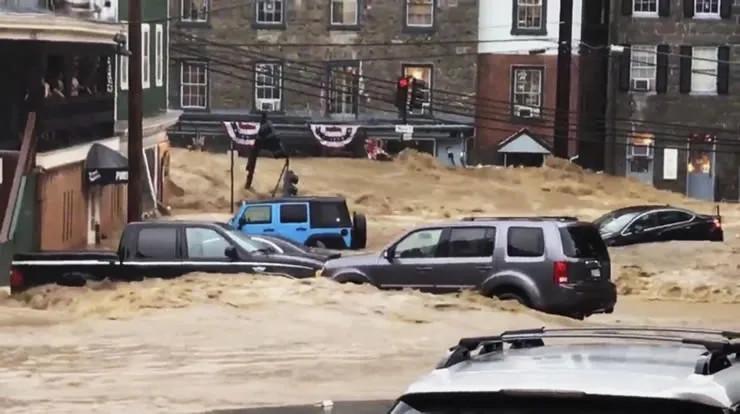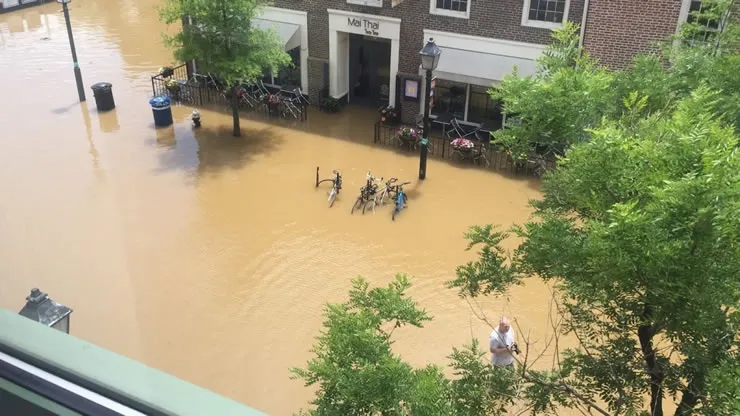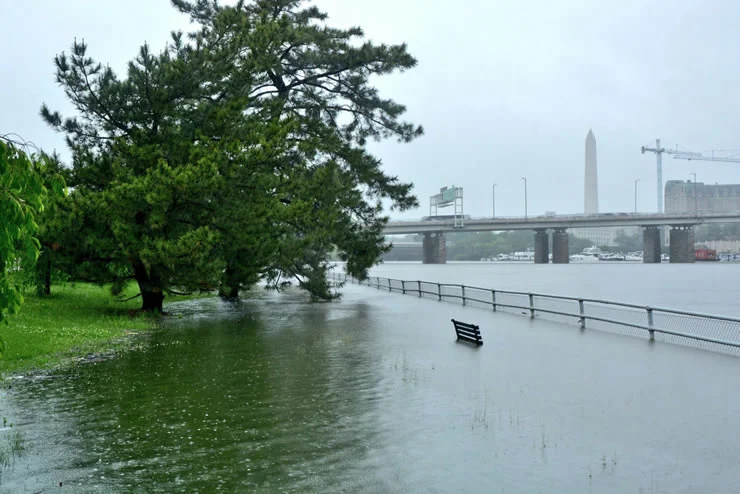Here’s a briefer on the record-breaking weather of 2018 and how to best prepare for water intrusion in 2019.

Ellicott City vehicles and storefronts during raging flood on May 27, 2018 – Courtesy of CBS News
2018 was a year of many climate firsts for the Maryland, Virginia & Washington, DC metropolitan area. In fact, it was the wettest year in history with Baltimore eclipsing its old rainfall record by 9 inches and Washington breaking a record that had stood for 129 years! According to NWS MARFC* the mid-Atlantic states experienced an unheard 33 flood events in 2018, compared to just 24 in 2003 and an average of only 12 yearly events dating back to 1930.
It is no longer a far fetched notion to see 6 to 8 inches of water or more flooding the shops of Old Town Alexandria, Virginia… or watching several inches of rain engulf the waterfronts in Washington, DC like a magnified king high tide, or even witnessing Ellicott City, Maryland’s Main Street transformed into raging white water rapids!

Old Town Alexandria experiencing first of two floods last year on June 5, 2018 – Image by Rita Abou Samra
So what does this all mean? A quick glance at the 2018 weather event photographs on this page makes it clear – residents and business owners in Maryland, Virginia & Washington, DC need to be prepared for anything Mother Nature throws their way, including massive amounts of water. Excessive water events like these hinder everyday home living, shut down business, and can introduce the contaminants and toxins that could arise from mold and sitting water.
As we march forward into 2019 there is every indication of continued events. While we hope never to see Maryland’s Patapsco River rise 17 feet again, storms are sure to come. And even if the Nation’s Capital region experiences less precipitation in terms of sheer quantity, it doesn’t take much during one heavy storm to introduce a few inches of water to close down offices and retailers, and make living conditions simply… unlivable.
Here’s some advice and ideas gathered for the benefit of both residential and commercial property owners to defend against flooding and flood damage. It all starts with:
Maintaining Your Property to Reduce Your Risk
- Crawl spaces and basements are vulnerable to water seeping through foundation cracks, pipe holes, vents, doors or windows. Water can also find its way between siding and foundation sills. It helps to make potential leak sources part of your routine maintenance – fill cracks in your foundation with cement; use cement or caulk to seal openings around pipes; and caulk the joint between siding and foundation.
- Ensure gutters and downspouts are clean and flowing properly. It’s important that gutters and downspouts empty properly into a storm sewer or a distance away from your property.
- Maintain the grade around the structure(s) on your property so rainwater drains away from the building foundation(s).
- Consider installing a (battery-powered or water-powered) backup sump pump if you rely on a sump pump to keep your residence or retail space dry. Make sure you understand the limits of both pumps.
- Consider investing in a generator or heavy-duty power inverter to cope with extended power outages. This can make the difference in some semblance of normalcy in day to day living, as well as minimize the effect of downtime on your business.
Protect Your Home or Business with Sandbags
While you can obtain or make your own sandbags, when there is a high risk of flooding check with your municipal government to see if sandbags are available for residents and businesses. Sandbags are a simple and effective way to prevent or reduce flood water and water damage. Sandbags can act as a barrier to divert moving water around instead of through buildings but DO NOT guarantee a watertight seal.

- Remove debris from the area to be sandbagged.
- If tied bags are used, flatten them and flare the tied end.
- If untied bags are used, fold the open end to form a triangle.
- To form a sandbag wall, place bags tightly against one another to form the first layer of defense.
- Stack additional bags on the folded or flared portion of the previous bag and stamp into place to reduce gaps and to form a tight seal.
- Stagger the second and subsequent layers of bags, similar to the pattern of bricks on a wall.
- Never use bags to wall your property completely. You could trap water between the sandbag walls and your structures, causing further water damage and encouraging mold growth.
- Do not rely on sandbags alone to protect your property. Use baffle boards (plywood sheeting) or sheets of plastic tarp with sandbags.
- Avoid disposing of sandbags in normal trash or recycling.
In extreme situations, you’ll want to protect your home or business from sewer backups as well.

Rising waters threaten Washington, DC over weekend of May 18, 2018 – Image by Dave Dildine/WTOP
Heavy rains over many hours can fill sewer lines and cause sewer backups and sewage overflow in some areas. It may also back up into homes and office spaces through floor or plumbing drains. There are several steps you can take to help prevent sewage backups into homes and small businesses.
- If you have a backflow preventer, make sure it is in working order as part of your routine maintenance and that it is closed as necessary.
- Stuff rags or other material into floor drains to stop or minimize the flow into your basement. BE SURE you can remove the blockage after the emergency has passed.
- Cover the drain with a plastic under a floor mat and weigh it down.
- Place a heavy object on the closed cover of basement toilets to prevent sewage from backing up.
- Restrict the use of plumbing as much as possible until rains subside. This includes dishwashers, clothes washers, showers and toilets.
- Use reasonable precautions to protect yourself from exposure to what may be contaminated water by wearing waterproof boots and gloves.
- After the rain stops, if sewage has come through a floor or plumbing drain, call a professional to address sewage removal immediately.
All in all, the best defense against water intrusion and damage is just that… defense. Hopefully this article has better prepared you to defend against future weather events in 2019 throughout Maryland, Virginia and Washington, DC. Should you find yourself dealing with flooding or water damage, call an expert as soon as possible for water mitigation and extraction, as well as any water damage remediation needed.
Good luck out there!
*National Weather Service Middle Atlantic River Forecast Center
Sharing is caring!







